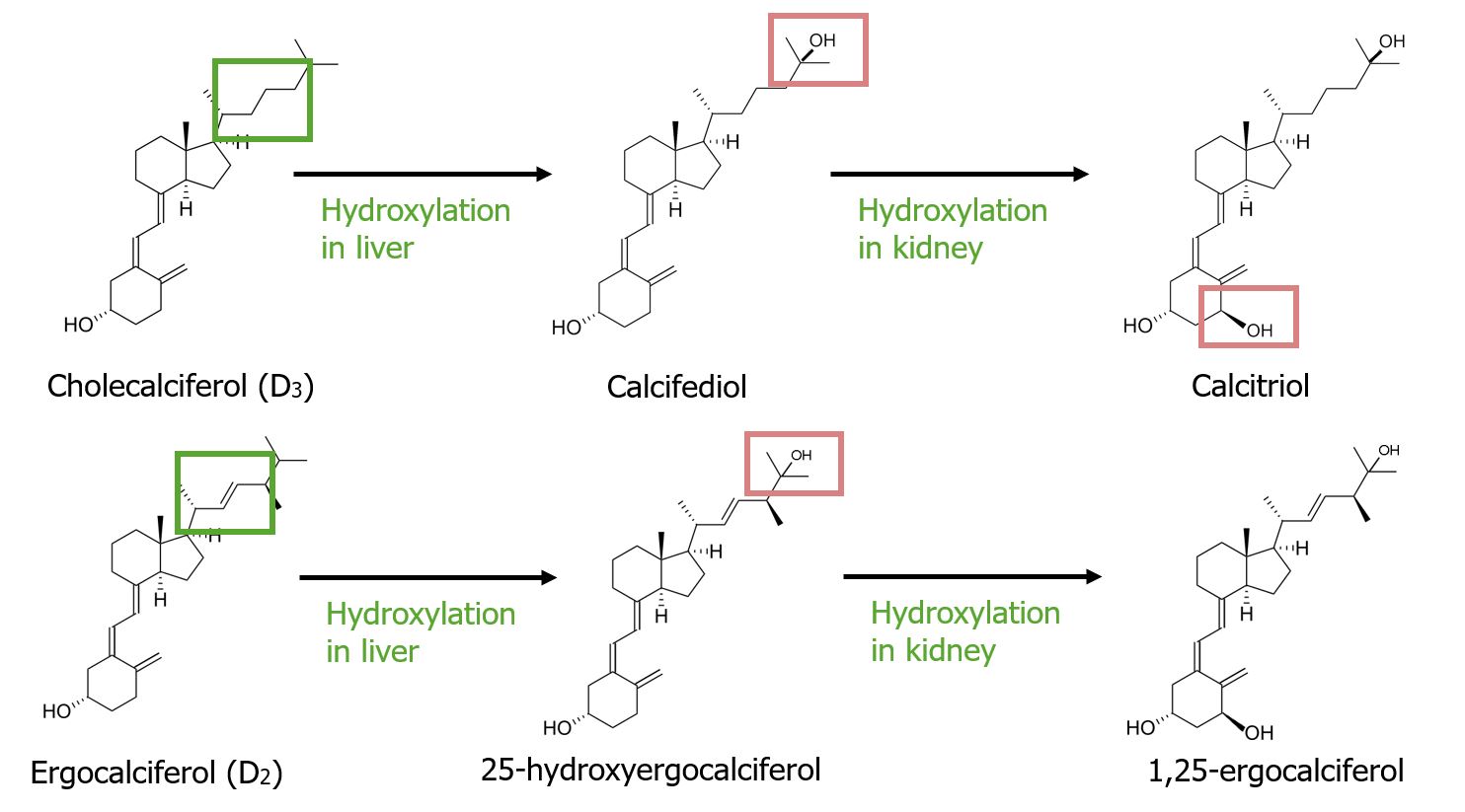Playlist
Show Playlist
Hide Playlist
Vitamin A: Introduction
-
Slides VitaminA,DCalciumHomeostasis Biochemistry.pdf
-
Reference List Biochemistry.pdf
-
Download Lecture Overview
00:02 In this lecture, I’m going to describe vitamins D and A, two of the fat-soluble vitamins and some of the very different functions that each one has. 00:11 Now, vitamins D and A, as I said, are fat-soluble vitamins. 00:15 They are important in the case of vitamin A for vision. 00:18 In the case of vitamin D, for calcium metabolism. 00:20 But that’s not the only thing that these vitamins do. 00:24 Vitamin A is also important for gene expression and differentiation that occurs within organism during development. 00:30 Vitamin D is also important for controlling gene expression and essential for a healthy immune system. 00:36 As we will also see, it has some anticancer properties as well. 00:40 Now, one of the things to be careful about with vitamins A and D is that because they’re fat soluble, excessive amounts of either one of them could be harmful because they get stored in fat tissue and can be released over a long period of time. 00:52 So these are two vitamins you don’t want to take in excess amounts. 00:56 Vitamin A, as I said, is fat soluble. 00:59 It is toxic at high doses and it’s actually possible for a person to overdose on eating too much liver from certain organisms like polar bears, so stay away from polar bears. 01:08 Vitamin A is stored in the liver and it occurs in three forms in the body. 01:14 The alcohol form is known as retinol and you can see it outlined on the screen. 01:19 On the far right of the molecule, there’s an alcohol group and that’s what gives it the –ol ending of its name. 01:25 Retinal is a related compound that differs only in containing an aldehyde group at the end of its structure. 01:31 And finally, retinoic acid has a carboxyl group at its end. 01:35 Now these three different molecules have three very different functions within our body. 01:41 Now, retinol is the storage form of vitamin A. 01:45 To store vitamin A, retinol is esterified to a fatty acid as you can see on the structure on the top. 01:51 Now, vitamin A comes in a variety of isomeric forms. 01:54 And the form that you see on the top for retinol is known as the all-trans form, that is all the double bonds are in the trans configuration. 02:01 Those double bonds can isomerize in the presence of light, meaning that light can actually physically change their structure. 02:09 The summarization of retinal is what gives rise to vision as we shall see. 02:13 And one of those isomers you can see in this structure which is the 11-cis retinal isomer. 02:19 And it’s this isomer that is stored within our eyes. 02:22 Retinoic acid is important for cell differentiation. 02:25 Without retinoic acid, we won’t form into the organisms that we do. 02:30 Now, vitamin A is produced in the body using beta carotene as a precursor. 02:34 And beta carotene is shown in the figure at the bottom. 02:37 Basically, if you cut beta carotene in half, you will get one of the forms of vitamin A that you see on the screen here. 02:45 Now, 11-cis retinal, as I said, is important for vision. 02:49 So I need to describe to you that process by which this occurs. 02:52 First, 11-cis retinal is bound to a protein called opsin. 02:56 And it’s through protein called opsin that retinal provides us with vision as we shall see. 03:02 The absorption of a photon of light by the 11-cis form of retinal causes the 11-cis form to flip back to the trans configuration. 03:12 So we can see this flipping process occurring here where we see it flipping on the top to the bottom or from the bottom back up to the top. 03:19 and this happens very readily with this form of vitamin A. 03:23 It’s the change in structure, the change in form, that actually provides the very first signal in our eyes that light has been detected. 03:32 So before I talk about the biochemistry of vision, I’ll just say a little bit about the actual physiology and the cell structure that gives rise to vision. 03:40 So vision happens as a result of light detection that occurs in specialized cells in our eye known as retina cells. 03:47 The opsin that I described earlier is the protein that actually holds vitamin A containing compound, the retinal, that allows us to have vision. 03:55 Now, notice that retina and retinal are pretty similar in terms of name, but they’re very different things. 04:02 We have two types of cells in our eye that detect light. 04:05 The most abundant cells that we have are known as rod cell. 04:08 And they provide very basic functions of light detection. 04:11 They don’t provide for differences in color, but rather simply detection of a photon of light. 04:18 The photo pigment that they contain, the opsin, contain links to the retinal, is known as rhodopsin. 04:24 The other cells that we have in our eyes are known as cone cells. 04:27 And they actually provide the color detection that we see when we see a well lit room. 04:32 They also have retinal linked to an opsin. 04:35 But the opsin there is a little bit different and so we call those photopigments, photopsins. 04:41 There are three types of cone cells. 04:43 One type specialized for the absorption of red wavelengths of light. 04:47 One type of cone cells specialized for the detection of green type of light and one specializes for blue types of light. 04:55 Now, to give you an idea of abundance, there are about a hundred and twenty million rod cells per eye and about 6 million cone cells per eye. 05:02 So eyes have pretty good resolution in terms of being able to detect small amounts of light. 05:10 The rod cells can detect. 05:11 They’re so sensitive that they can detect individual photons of light. 05:15 Now, that detection comes at a price. 05:17 They can’t tell the color of that light, but they can tell whether or not light impinged upon them. 05:23 The opsin as I said earlier contains the 11-cis retinal and in that form, it’s known as rhodopsin. 05:29 The retinal in rhodopsin isomerizes in response to the light and that isomerization causes the retinal to change form. 05:37 So instead of being bent as we saw earlier in the structure, it straightens out. 05:42 Well, that straightening out of the retinal that happens in the presence of light causes the rhodopsin that contains it to also change its structure. 05:51 Now, one of the things we’ve seen in other lectures that I’ve given here relates to small modifications in protein structure. 05:58 Small modifications in protein structure can have very big effects on what the protein actually does. 06:03 And that’s very much the case here with rhodopsin. 06:06 So these retina cells that I’m describing to you are very sensitive and that sensitivity allows them to very easily send signals to the brain that they detected something. 06:17 Those signals happen as a result of chemical signals that arise in the nerve cells. 06:22 Now, this chemical process is kind of complicated. 06:24 So I’m going to take you through it slowly. 06:27 The unstimulated optic nerve cells are what we call unpolarized, meaning that they have an even distribution of ions on the outside and on the inside of the cell. 06:37 This is very different from other nerve cells because they start out in a polarized fashion. 06:43 Light stimulation that happens on the nerve cells of the eye, however, caused hyperpolarization. 06:50 This is exactly the opposite of other nerve cells. 06:53 Other nerve cells start out hyperpolarized and stimulation causes them to become unpolarized. 06:59 So we see the reverse of the process that’s happening with nerve cells in our eyes.
About the Lecture
The lecture Vitamin A: Introduction by Kevin Ahern, PhD is from the course Vitamins. It contains the following chapters:
- Vitamin D and Vitamin A
- Vitamin A - Rods and Cones
Included Quiz Questions
Which statement regarding vitamin A is true?
- It has 3 primary forms: retinol, retinal, and retinoic acid.
- It is water-soluble.
- It is stored in the kidney.
- It has 2 forms: retinol and retinal.
- Its primary form is retinol.
Which statement regarding vision is true?
- Double bonds play critical roles in light detection.
- Retinol is the light-sensing pigment.
- Light detection occurs as a result of rotation of a single bond.
- Triple bonds play critical roles in light detection.
- The absorption of a photon leads to the conversion of 11-trans retinal to 11-cis retinal.
Which statement regarding specialized retinal cells is true?
- They contain opsin, which holds retinal.
- They are devoid of opsin.
- They are devoid of photopigments.
- They include cones, which detect light.
- Stimulated optic nerve cells are unpolarized.
Which statement regarding rod cells is true?
- They become hyperpolarized when stimulated by light.
- They contain the protein opsin, which isomerizes in the light.
- They start out all-trans-retinal.
- They become depolarized when stimulated by light.
- Rod cells need at least 10 photons to detect light.
Which statement regarding vitamin A is correct?
- Vitamin A plays an important role in gene expression and cell differentiation during the developmental phase.
- Vitamin A does not play any role in human vision.
- Vitamin A plays an important role in hearing and taste.
- Vitamin A is not fat-soluble, and therefore, an excess of this vitamin can lead to toxicity.
- β-carotene blocks vitamin A synthesis.
Customer reviews
5,0 of 5 stars
| 5 Stars |
|
1 |
| 4 Stars |
|
0 |
| 3 Stars |
|
0 |
| 2 Stars |
|
0 |
| 1 Star |
|
0 |
It is really so good thing to take more information and I like so much the way of the explain for the teacher thank you so much for this helping for students




